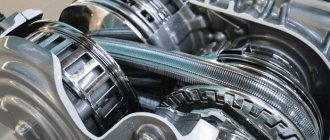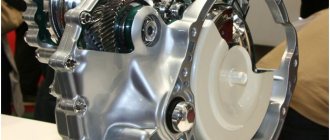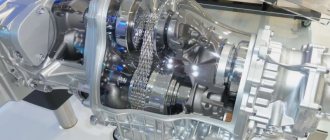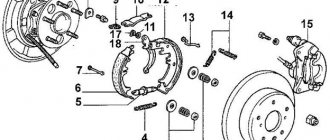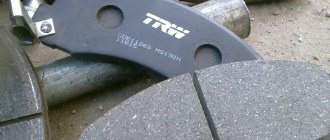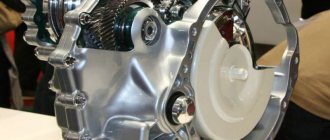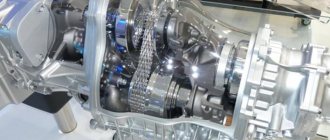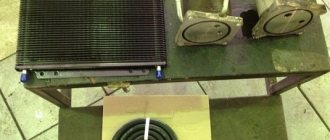One of the transmission options for the Mitsubishi Outlander is a CVT. Its reliability and durability are controversial among owners. This is due to the fact that the service life of a continuously variable transmission is directly related to compliance with operating recommendations.
For example, an untimely oil change in a variator can cause serious problems, the elimination of which will require large financial investments.
Use of a variator on Mitsubishi Outlander cars
The Outlander uses a Jatco JF011E variator. Since May 2014, the Mitsubishi Outlander 3 has been using the Jatco JF016E CVT. According to Mitsubishi's internal classification, the continuously variable transmission on front-wheel drive vehicles is called F1CJA. On all-wheel drive Jatco vehicles, the JF011E is designated model W1CJA. More detailed information about which CVT is installed on the Mitsubishi Outlander is presented in the table below.
Table - Modifications of continuously variable transmission on Mitsubishi Outlander
A feature of the Mitsubishi Outlander CVT modification is the lack of interchangeability. There is a difference at the level of hydraulic units, seats and ECUs. Therefore, when purchasing a contract transmission, it is extremely important to pay attention to the modification.
The Jatco JF011E variator has good performance characteristics and high reliability. Therefore, it has found application on cars of other brands. For example, it is found at Renault, where it is assigned the model FK0/FK8. Jatco JF011E is installed on both Dodge and Jeep. There it is called CVT/CVT2. The transmission has gained wide popularity from the Nissan company. According to the internal classification, the variator is designated RE0F10A/B/C. You can get acquainted in more detail with the cars on which the Jatco JF011E is installed in the table below.
Table - List of cars on which Jatco JF011E is used
Third place - OVERHEATING
Here I included two points at once: slipping in mud or snow , as well as towing cars and various “motorhomes” or trailers .
All these actions lead to overheating of the variator; doing so is not correct! In general, I am touched by comments like: - “I have a NISSAN QASHKAI or a MITSUBISHI OUTLANDER, with a CVT, of course, this is an SUV (the dealer said there is all-wheel drive). Why don’t I rush into the field and compete with the people in UAZ or GELIKA vehicles!”
Actually, you can go there once, but it’s not a fact that your CVT will survive such “rides” (and all-wheel drive there too, it simply turns off so as not to overheat the clutch).
If you are stuck “specifically”, frying and turning this transmission is SIMPLY IMPOSSIBLE (here this rule is even more critical than with an automatic transmission)! Remember - “slippage” very quickly leads to overheating . High temperatures negatively affect the variator belt or chain; it can stretch. If this happens, then it slips along the shafts and leaves marks there. If the scuffs are deep, the CVT will not work properly.
What your transmission is capable of is getting out of moderate off-road conditions (without intense loads), or overcoming a snowy yard. CVT is a city dweller! If you want to bury your car up to the hood in mud, buy a manual UAZ
ABOUT LARGE LOADS . Again, if you have a small car (class B), a 1.3-liter engine, and you suddenly decide to drag your friend to the service station, and he has a SUV or a class “D” car. YOU CAN'T do that, it's not right!
Let me remind you once again that your shafts (engine and wheels) are connected by one belt or chain, and they are designed for a certain weight (often with a margin, but not infinite). If you start pulling a mass that exceeds the tolerances, again this will put a large load on the variator, overheating and all the ensuing consequences. If you want to help a friend, give him the tow truck number.
Main technical characteristics
The CVT has gained the greatest popularity on cars equipped with 2-liter power plants. Also, a continuously variable transmission is sometimes used in conjunction with a 2.4-liter engine. You can find out in more detail the main parameters of the Mitsubishi Outlander from the table below.
Table - Technical characteristics of Mitsubishi Outlander with CVT
| Index | Meaning | |||
| Engine volume, l | 02.04.2019 | 2.0 | 02.04.2019 | 2.0 |
| Power, hp | 170 | 147 | 167 | 146 |
| Fuel type | petrol | petrol | petrol | petrol |
| Fuel consumption per 100 km: | ||||
| in the city | 12.06.2019 | 10.06.2019 | 10.06.2019 | 10.03.2019 |
| on the road | 07.05.2019 | 7 | 06.04.2019 | 06.01.2019 |
| Acceleration to 100 km/h, s | 10.08.2019 | 12.03.2019 | 10.05.2019 | 12 |
First place - firmware
You know, I never attached any importance to this. However, it is important to update a MODERN variator, and it needs to be done correctly.
In general, I don’t remember now what kind of “cheese-boron” my friend had an old NISSAN QASQAI, which was about 8-10 years old. He rode the CVT for 120,000 km and did not suffer any breakdowns, he liked everything, so he sold it.
Then he had other cars, and for his wife he bought a NISSAN JUKE with CVT (from the old memory of the brand).
So there were a lot of problems with this car. Variator errors constantly appeared, and it went into emergency mode and that’s it (all this started at about 30,000 km) and continued with “periodicity”, in my memory it happened 2-3 times exactly.
They took the car to the dealer, they connected the equipment to the brain, did some magic, and gave the car back. The car drove for some time and again the same error.
“So what is the reason,” you ask? My answer (in the end we overcame this problem) is that the problem was in the firmware, it did not regulate the oil pressure correctly, due to which the “cones-shafts” were not compressed enough. The belt could slip, as a result, the electronics saw all this and an error came out.
With the third or fourth firmware, the whole thing was corrected, no more emergency situations appeared. BUT, as the master said, it’s better to go to a service station during the warranty period, if such new firmware appears, they are required to download them, and you may not even know about it.
Now let's watch the video version of the article.
This concludes my materials, I think you found it useful. Read my blog, subscribe to the YOUTUBE channel, there will be many more interesting videos. Sincerely yours, AUTOBLOGGER
( 13 votes, average: 5.00 out of 5)
Similar news
Adaptive automatic transmission (automatic). What is it, how does it work. A couple of words.
Automatic transmission parking mode. The principle of operation, how it works in the “machine”.
Add a comment Cancel reply
Oil selection and filling volumes
The manufacturer officially recommends using exclusively DIA QUEEN CVTF-J1 or DIA QUEEN CVTF-J4 oil. Since the variator is also used by other automakers, there are other suitable lubricants:
- PSA 9735.EF;
- Nissan CVT NS-2;
- MOPAR CVTF + 4;
- ELF ELFMATIC CVT.
All of the above lubricants are manufactured using identical technologies at the production facilities of Total (ELF) and Idemetsu. Therefore, oils have similar properties, which is confirmed by numerous reviews from car owners.
The amount of oil required depends on the method of changing it. The table below describes the most popular methods.
Table - Required amount of oil depending on the method of changing it
| Way | Required volume, l |
| CVT filling volume according to documentation | 07.01.2019 |
| Replacement using a special device | 10.12.2019 |
| Partial replacement with removal of the pallet | 04.06.2019 |
| Draining oil through a special hole and then refilling it without removing the pan | 03.04.2019 |
The most preferred method of changing the oil is the method of removing the pan. This is due to the fact that at its bottom there are two magnets that catch metal shavings. Changing the oil without removing the pan is recommended only during the first maintenance. It is generally undesirable to use a special device to displace lubricant. It breaks off abrasive particles and spreads them throughout the variator. This significantly reduces the resource of the Mitsubishi Outlander continuously variable transmission.
List of required tools
In order to replace the lubricant in the Mitsubishi Outlander 3 variator, you need a list of tools from the table below.
Table - Tools and materials required for changing the oil
| Tools and materials | Note |
| Cleaner | To remove traces of oil from the pan, as well as to wash magnets and the coarse filter |
| Head | "at 10", "at 19" |
| Vorotok | With extension and ratchet |
| Watering can | For filling grease |
| Tara | Capacity from 5 liters, quite wide |
| Measuring containers | To determine the amount of oil drained |
| Rags | To eliminate grease leaks and clean contaminants |
Let's sum it up
As you can see, close cooperation between Mitsubishi and one of the world's largest manufacturers, Jatco, made it possible to install on the Outlander first the fairly reliable JF011E gearbox, and later the Jatco CVT 8.
As a result, the CVT 8, along with the latest X-Tronic CVTs, clearly demonstrates that a CVT can be quite reliable and has a long service life, and can also successfully compete with traditional automatic transmissions and robotic gearboxes.
As a result, the CVT transmission can easily cover 200 thousand km. and more. The main thing is to follow the operating rules, promptly change the oil in the variator, and also monitor the condition of the CVT belt. Finally, we note that if we compare a modern CVT and maintenance-free automatic transmissions, the service life of these transmissions today is at approximately the same level.
Typical problems identified during operation
One of the main problems of the variator on the Mitsubishi Outlander is its constant overheating during the summer heat. As the temperature increases, significant wear occurs on the elements of the continuously variable transmission and it may fail.
To avoid costly repairs caused by overheating, car owners install an additional cooling radiator. It allows you to reduce the temperature. On vehicles equipped with additional radiators, an increase in the oil fill volume of the continuously variable transmission should be taken into account.
If you follow the oil change schedule and adhere to other recommendations of the car manufacturer, the belt can last more than 400 thousand km. Otherwise, it may wear out and stretch. The belt begins to scratch the cones and slip.
The Jatco JF011E variator uses two modifications of belts. The simpler Bosch 901066 has ten tapes. It has a lower price. The Bosch 901047 reinforced belt has twelve belts in its design. This is why it is 6-10 thousand rubles more expensive than a simple belt. Moreover, both chains are completely interchangeable.
The most expensive CVT breakdown is associated with damage to the cones. Their wear leads to the appearance of defects in all associated elements. Therefore, the situation often arises that if the cones are damaged, it is more profitable to buy a new or contract transmission than to carry out repairs.
A common problem with the Mitsubishi Outlander variator is the failure of one or more shaft bearings of the continuously variable transmission. Symptoms of a malfunction are hum, noise and other extraneous sounds that come from the unit. In this case, it is highly undesirable to delay repairs. Failure of the bearings leads to misalignment of the cones, which causes severe wear. Even short-term use of the car in this case leads to a significant increase in the cost of repairs.
The stepper motor also causes variator breakdowns. The electric motor itself has a long service life, but its foot, which controls the position of the cones, breaks off quite often. Because of this, the variator loses its ability to change the gear ratio.
Due to overheating, the rotation speed sensor fails. Replacing it is rarely accompanied by difficulties.
In the absence of timely oil changes, the line begins to clog. The throughput of the solenoids decreases, and the load on the oil pump increases, which negatively affects its service life.
Lifehack: how to meet the warranty
The experience of adequate - read, objective, and not fanatical “blinded” - owners testifies to the fact that the box is different. Some CVTs show themselves to be relatively tenacious even under abnormal conditions (to be clear, abnormal, not extreme), while others, on the contrary, are capricious and delicate. But there is a general trend. The risk of CVT failure becomes higher with inhumane operation and after reaching a certain mileage.
Several years ago, members of a club of fans of one model with CVT, in fear of getting repaired after the warranty period had expired, personally disabled the unit before reaching the desired mileage. This was done in the following way: every morning the car was pushed with its front wheels into a fairly high curb, which is not so easy to overcome, and the gearbox was slightly loaded with revolutions. Regular “training” finished off the variator during the warranty period, after which the manufacturer replaced the gearbox free of charge. We will not name the club, but, anticipating reader skepticism, we note that these are not stories, fairy tales or fiction - the information was received from one of the community members.
Review of feasibility of repairs
The Jatco JF011E continuously variable transmission has good maintainability. Therefore, if breakdowns occur, in most cases repair is recommended. An exception is a CVT with a mileage of more than 400 thousand km or with serious damage to most elements, including cones.
Contract CVTs in retail cost from 50 thousand rubles. In normal condition, a supported unit can be found for 100 thousand rubles. A new continuously variable transmission from an official dealer costs from 220 thousand rubles.
